Table of Contents
We are a participant in the Amazon Services LLC Associates Program, an affiliate advertising program designed to provide a means for sites to earn fees by linking to Amazon.com.
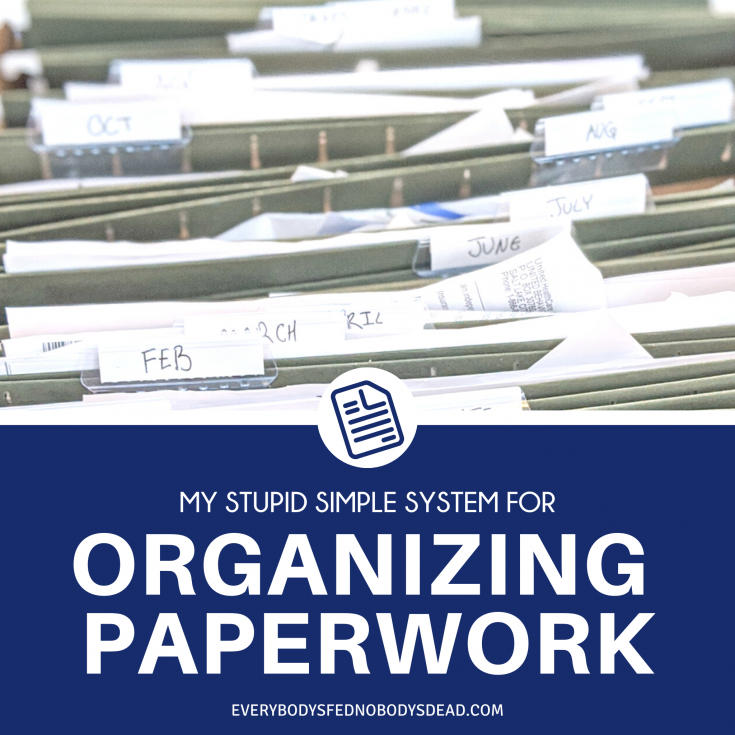
If you’ve ever been stressed out by the stack of papers piled high on your kitchen counter, Mama, I feel you.
Motherhood is filled with laundry, stinky diapers, and constantly trying to convince our goblins kids to eat something other than mac ‘n cheese. Really, it’s no surprise that things like organizing paperwork fall low on our priority list.
Throughout the day, it’s easy to toss bills, receipts, and your kid’s art project on the counter as you race between activities. Then suddenly your kid remembers he needed you to sign the field trip permission slip that he gave you last week, and you dive through your paper stack, praying you’ll find it.
Situations like this give me severe anxiety. As a child, I frequently lost things, and now not being able to find something I’m looking for is a huge pet peeve. I work hard to have a specific place for everything in my home, and I continually look for ways to cut down on clutter.
There is a mental cost of clutter, and since mental health is so important, reducing clutter (and stress!) should be a priority for all moms.
Why This System Works for Us
I’ll be honest with you – my method of paper organization is not the fanciest or most efficient system by a long shot. A quick Pinterest search will show you some incredible systems for organizing paperwork with binders and color-coding and wall organizers…
These systems are all fantastic, but right now, during this stage of life, I don’t have the time or energy for any organization that involves a lot of steps.
One of the biggest reasons that we fail to maintain the organizational systems we put in place is the number of steps required.
We see the systems other people use to organize bathrooms, closets, or kitchen pantries, and we try to replicate those systems without realizing they may not fit our own family’s needs.
It’s important to evaluate organization systems before implementing them, and you can always adjust how you organize your closets, drawers, mudroom, etc. as life inevitably changes.
So rather than setting myself up for failure, I was realistic in knowing that the simpler I made my system for organizing paperwork, the more likely I’d actually follow through.
And it worked!
How to Deal with Paper
The first step to organizing paperwork is simply to reduce the amount of paper that comes into your home. Set your bills to come via email, remove junk mail from your life, save business cards in Evernote, and don’t bring home receipts for things less than $10. Make a conscious effort to notice the papers you’re bringing home.
Here are some great tools to help reduce junk mail:
- Opt-out of unwanted phone books.
- Opt-out of Valpak mailers.
- Pay $2 to DMA Choice to stop all junk mail, choose which categories of mail you no longer want (catalogs, credit card offers, etc.), or unsubscribe from each individual company in their database.
- Use Catalog Choice to unsubscribe to catalogs one at a time.
- Unsubscribe to preapproved credit card and insurance offers through Out Out Prescreen, an FTC-recommended service through the major credit bureaus.
- Download the Paper Karma app and snap a pic of unwanted mail to be instantly unsubscribed!
- Use an app to keep digital copies of receipts.
Next, get in the habit of always dealing with papers and mail as soon as possible. When I walk in the front door with the mail, I immediately go through it and throw all the junk in the recycle bin. Whatever is left in my hand then either needs to be filed or dealt with by the end of the day.
The Filing System
The crux of this system is the main filing box. This box sits right inside my downstairs closet, so it’s always easily accessible and only a few steps from the kitchen counter.
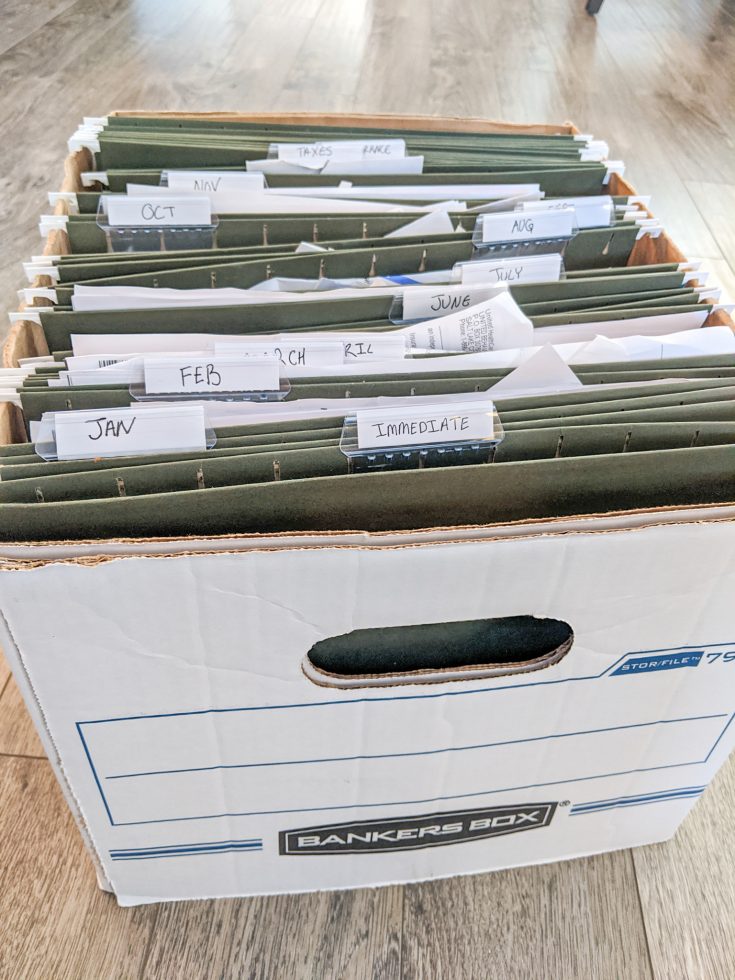
My filing system is a simple file storage box (more commonly called a Bankers Box) with hanging files labeled by month.
Remember how I said before that the amount of steps required reduces the likelihood that a system will work? This is why I don’t organize my file box by more specific categories, like receipts, medical papers, bills, etc. By putting all papers in the folder for a single month, I’ve reduced the amount of time I have to spend deciding where each paper in my hand needs to go.
If I have a paper that needs to be saved or that I’m not ready to part with, it goes in the folder for the current month. Easy peasy.
Here’s an example of items in my January folder:
- A Target receipt
- Paperwork and notes I took during a meeting
- A medical bill I paid online
- Documents from my health insurance
- Tracking labels for returned items
- A thank-you note
- Coupons expiring soon
- An instruction manual
- Date night concert tickets
To recap: I walk into the house and look through my papers. Anything that can be recycled immediately is, and then if I’m left with bills or paperwork to fill out, I do it immediately or leave it in plain sight to deal with after my toddler goes to bed. Everything else then goes right into the monthly folder in the file box in the closet.
Done! Not too bad, right?
Now obviously, because this system is very simple, you will have to dig through your monthly folders when you’re trying to find something. And while that’s not as efficient as, say, having a folder just for receipts or insurance paperwork, you still only have to look through one folder at a time.
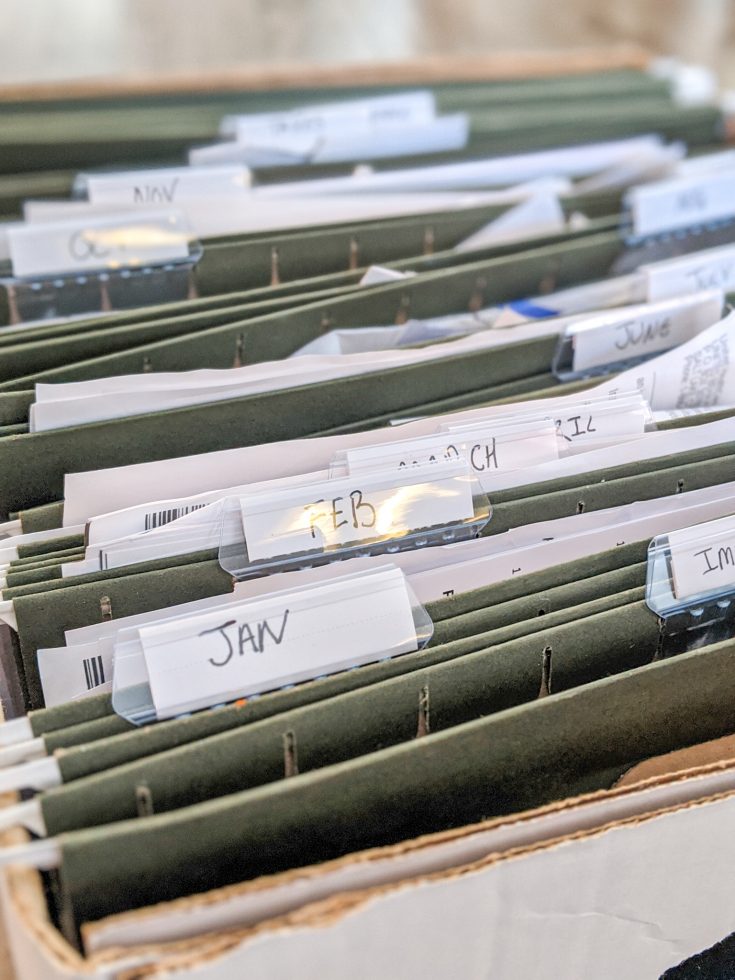
Part of the reason I like this system is that I can easily remove each month’s folder from the box and open it on my kitchen counter when I need to find something specific. I can also direct my husband to “look in the May folder” or “check the February and March folders” when he doesn’t know where to find a receipt for an item he wants to return.
Is this paperwork system perfect? No. But is it simple, easy to expand, and customizable? Absolutely.
The Yearly Purge
The second part of this filing system is the yearly paper purge. Since this isn’t something I have the time or energy to do weekly, monthly, or quarterly, I find that going through all of my papers at the end of the year is the perfect way to clear out my file box folders.
Dedicating just an hour or two to go through all of our paperwork every year is manageable for me, especially since I can do it while watching TV!
Over the years, I’ve discovered that most of the papers in my home fall into one of these categories:
- Financial – Receipts, tax information, bank statements, loan paperwork, etc.
- Healthcare – Hospital bills, medical records, prescription information, etc.
- Warranties – Instruction manuals and warranty paperwork for furniture, electronics, etc.
- Home – HOA documents, homeowner’s manual, water system papers, etc.
- Insurance – Health insurance, car insurance, home insurance, job insurance, etc.
- Memories – Movie ticket stubs, birthday cards, photos, letters, art projects, etc.
- Railroad (Job) – Rulebooks, timesheets, pay stubs, etc.
Since everything we keep can fit into one of these seven categories, each category gets its own box.
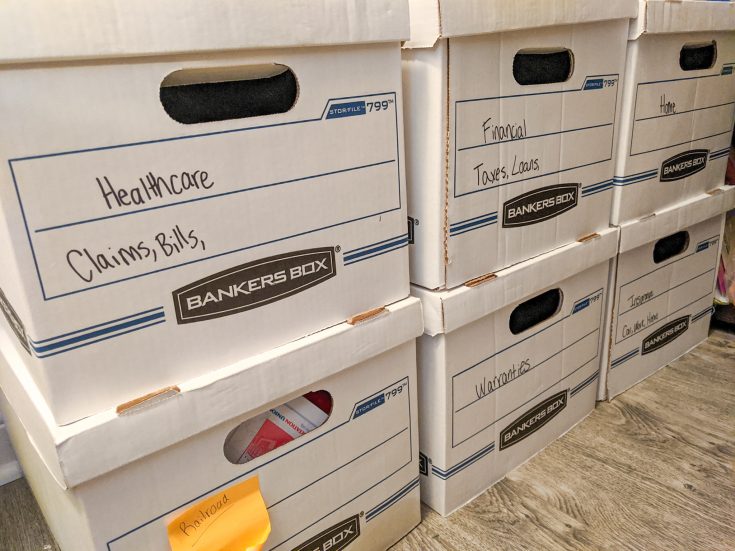
So if you’re keeping count, I have a total of eight file boxes in my home: seven for each paperwork category and one with monthly folders for my daily papers.
While the main file box is always open and easily accessible, the other seven boxes are stacked away in a closet, since I only get into them a few times a year.
In December, when I do my Yearly Paper Purge, I get out all of my boxes and put them on the floor in my living room. Then I take sticky notes for each category (as well as sticky notes for items that need to be shredded, recycled, or saved for tax season) and place them on the floor. This visual reminder helps me remember what categories each item goes in, and it keeps my piles from getting mixed up. It would suck to accidentally shred important documents!
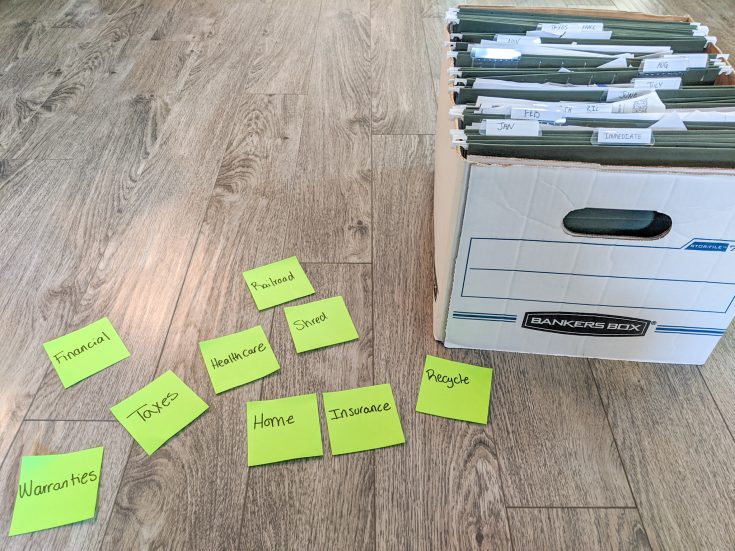
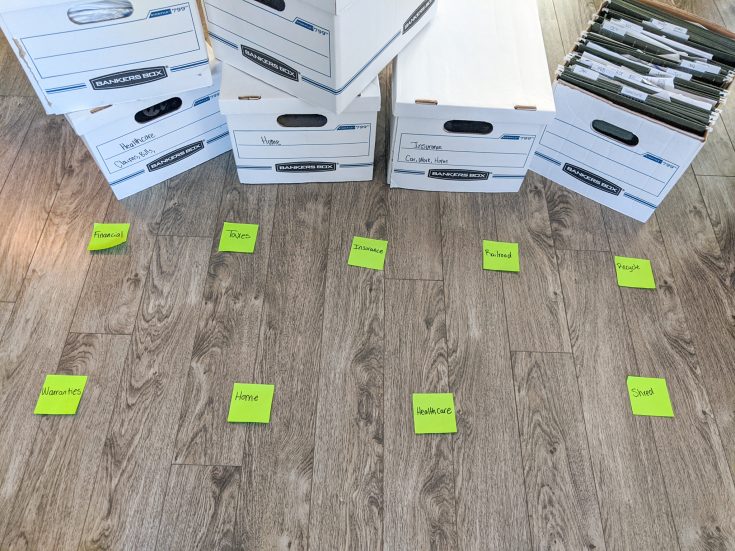
Then I dump out the contents of my main file box and get to work.
This whole process takes about an hour or two. I usually pull out my recycle bin and keep it next to me, since I always have a lot of receipts (gas, eating out, grocery, etc) I no longer need to keep.
I also check to make sure that there aren’t any sensitive documents that need to be put in the fireproof safe, and I look for ways to make digital copies of as many items as possible.
At the end of the process, my main file box is empty and all remaining papers now have a new home, either in the recycle bin, the shredder, or one of the seven categorized boxes.
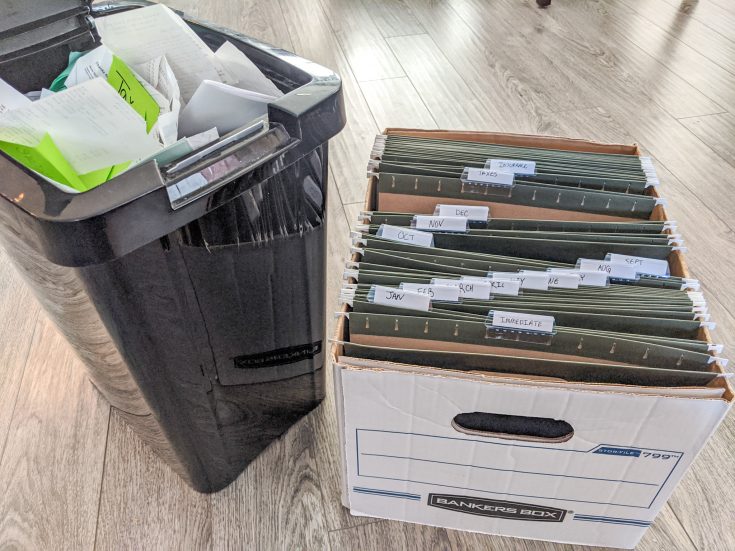
Keep It Contained
Aside from being the cheapest option, I love the size of the cardboard storage boxes for organizing paperwork. These boxes can hold quite a bit and they’re easy to move and stack. But they’re not huge, and at some point, you’ll have to reduce the contents to make more room.
My system for organizing paperwork keeps me from holding onto everything; I have to use discernment to decide what’s truly valuable.
Every few years when I do my yearly paper purge, and before I begin sorting the papers from my main box, I look through the contents of the categorized boxes to see what I can get rid of to make more room. I probably keep more financial documents than I need to*, but over the years some papers are no longer needed (car insurance paperwork for a car we no longer own, bank statements from an old bank, old instruction manuals, etc.).
*When my husband was applying for his job, he was put through an incredibly invasive background check that took us weeks to finish. There was a lot of paperwork to track down and find, and we had trouble getting records from previous employers that were no longer in business. That stressful experience has made me very cautious about getting rid of financial papers.
And for my memory box, which is often the most full, sometimes I group similar items (movie tickets, postcards, love letters, etc.) and use them for a craft project or stick them in a scrapbook.
Pace Yourself
As I said at the beginning, this paper organization system is customizable. Even though the yearly purge might sound stressful, or you have no time right now to spend going through papers from five years ago, nothing has to change overnight.
Here are a few tips to help you make this work for you:
- If a box with monthly folders sounds like too much work: Throw all of your papers in a single box or basket that you keep on your counter or in a kitchen cabinet.
- If you’re not sure what to keep: Check out this post.
- If you don’t want to sort all of your papers: Ask for help and keep the categories to a minimum (just because I have seven categories doesn’t mean that three or four categories won’t work for you!)
- If you don’t want to spend time looking at old documents: Don’t! I mean, at some point, yes, you should probably get rid of bank statements from 10 years ago, but no one said you have to do this right now. If you want to do the yearly purge, but you don’t want to take time to make extra room in your categorized boxes, skip it for a year (or four!).
- If you’re worried you’ll still lose things: Use a Rocketbook to take notes and keep digital files! Then you can write down where you put something important. The technology isn’t quite there yet but within the next few years, you should be able to tell your Google Home device to remember where you put things for you.
- If you can’t deal with mail or papers as soon as you get them: Designate a “holding spot” for items you need to address soon. Warning: this can easily get out of hand, and it takes a lot of discipline to come back to things later, so I don’t recommend this to everyone. But if you can get in the habit of clearing out the “holding spot” at the end of each day, having a spot on the counter or a mail holder on the wall can be a great way to stay on top of important papers.
I have THIS hanging inside my main closet and I use something similar to THIS on my countertop. While products like these can help keep the clutter at bay, it’s important not to just use them as a dumping spot – these organizers are meant to be temporary storage.
Make It Work for You
Motherhood is hard enough without wasting time looking for things you can’t find. That’s why I take the time to set up organization systems that work for me. My pantry has a specific layout, my spices are in alphabetical order, there are labels on each shelf in my fridge, and my junk drawer is actually organized into different sections.
And no, before you ask, I’m not OCD*. I just really care about everything having a place in my home.
*Just because you like things to be a certain way or you prefer order does not mean you suffer from OCD, a real disorder that involves impulsive actions and affects daily behavior. If you believe you could be dealing with true OCD, please contact a doctor immediately.
This doesn’t mean that my home is always clean, and I’ve definitely had to redo organizational systems over time to adapt to our changing life.
But I’m not aiming for perfection! I’m striving to create a home that works FOR me, rather than against me, and after years of trial and error, I’ve learned what works for me.
Mama, don’t get caught up in beautiful organizational systems that are unsustainable for your family. Don’t beat yourself up for not having your home completely organized at all times. Just look for small ways to streamline your home and your sanity.
How do you keep your papers organized? Let me know in the comments, and please share this post with your friends!
Posts You Might Like:
- How to Set Your Priorities in Life
- 15 Super Simple Ways to Practice Self-Care
- How to Throw an Amazingly Average Birthday Party
- How to Choose Your Word of the Year
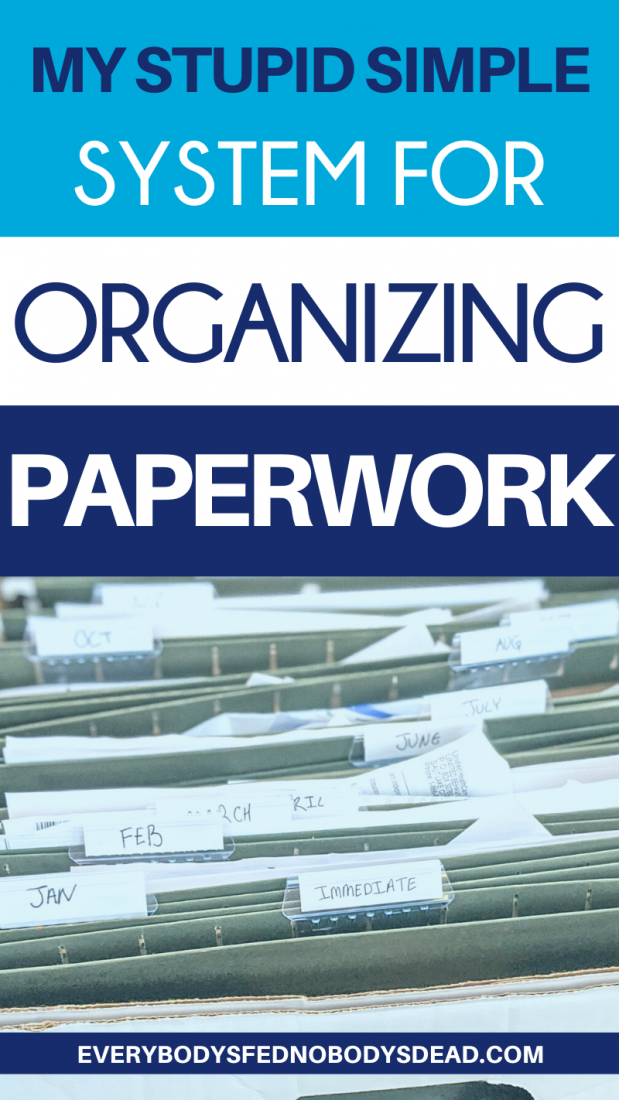


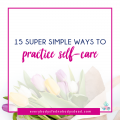

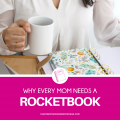

Leave a Reply
You must be logged in to post a comment.